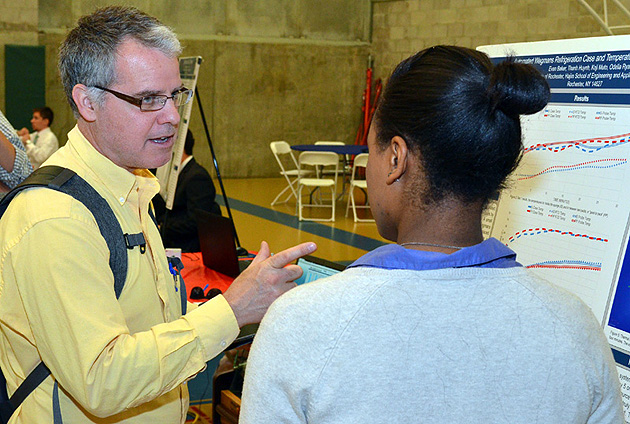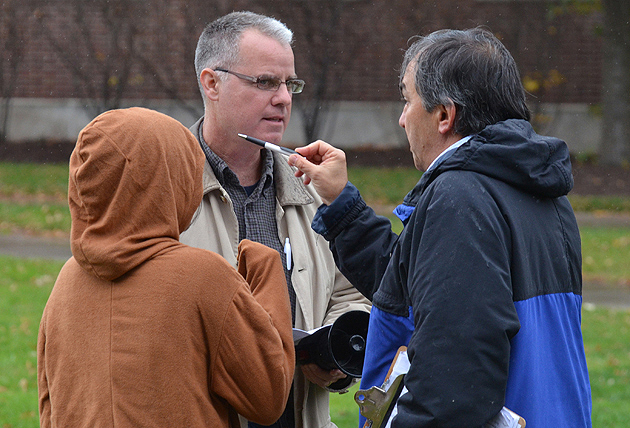Chris Muir is students' choice for engineering professor of the year
Associate Prof. Chris Muir, center, helps referee the annual Hajim School pumpkin launch with MechE Department Chair John Lambropoulos, at right, and Thanh Huynh, student president of American Society of Mechanical Engineering chapter (back turned).
Chris Muir, Associate Professor of Mechanical Engineering, remembers when he was a college student, taking a course equivalent to one he now teaches to sophomores.
“We did a lot of cantilever beam problems, and I thought to myself ‘I’m never, ever, going to do one these,’” Muir relates. “And yet -- and I tell my students this -- one of the first jobs I had at Kodak was analyzing spring clips in cameras, which is essentially a cantilever beam problem.”
Muir, completing his first year as a full-time faculty member after 18 years as a principal engineer at Eastman Kodak Co., does that a lot in class: Reminding students, based on his own industry experience, of the relevance of what they are being taught.
That’s one of the reasons he is this year’s recipient of the Undergraduate Engineering and Applied Sciences Professor of the Year Award from the Student Association.
“Professor Muir constantly strives to bring in real-world experience for students by sharing his experience of working at Kodak,” Yuting Yang ’16 of MechE wrote in her nomination letter.
But there are other reasons for the award, as attested by these supporting comments Yang gathered from other students: “He is a great coach, relaxed and approachable” . . . “consistently gives the best lectures I’ve ever heard in my time at the U of R” . . . “by far the most personable, hilarious, genuine professor on campus” . . . “always willing to spend one-on-one time with you to help you solve a problem” . . . “most of his students are interesting going into the industry, so we all really respect and look up to him despite his self-deprecating humor.”
As an adjunct for several years, Muir taught one class a year. Now he is a full time “teaching” professor. This semester the courses he taught in senior design, introduction to solid mechanics and engineering computation were taken by more than 150 students.
“It was hard work, involving a lot of preparation,” Muir acknowledges.
Muir doesn’t lecture from the textbook he picks for a class; doesn’t even require students to attend his lectures. But those who do will hear the material covered in a different way. “There are often approaches to the derivation of a theorem that are handled one way in the book, but I may have picked up a way I thought was a little bit simpler and more straightforward, and that’s what I’ll cover in the lecture,” Muir says.
One of his key responsibilities is teaching the fall and spring design classes that are required of all seniors, and that culminate in capstone projects carried out by teams of three students.
“By the time they’re seniors, they've been almost terminally educated,” Muir says jokingly. “They know how to sit in class and take notes, how to take a test, how to go through all that stuff. What I try to give them is an opportunity to apply the things they’ve learned.”
And one of the big takeaways of that experience is learning that “It’s okay that things don’t always work exactly the way they did on paper. You still have to make them work, and that’s where you often learn the most,” Muir says.
Muir also gets high marks from department chair John Lambropoulos, who appreciates Muir’s ability to communicate effectively not only with students but industry representatives who sponsor some of the senior design projects.
Muir was a valuable liaison this year, using his industry experience to help students refine their project proposals before they were sent to companies, Lambropoulos explained. But Muir also helped the companies come up with projects that could realistically be completed in the time available to students.
“Chris played an important role in taking a project and cutting it into a piece that could be addressed by three seniors in four months,” Lambropoulos said. “This was very important, so that students could feel they had actually delivered something, and the companies could feel ‘yes, this is what you promised to do and it got done.’”
Below, Muir talks with one of his senior design students during the Hajim School Design Day poster session.


